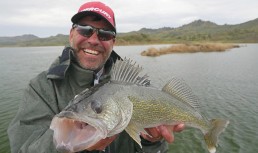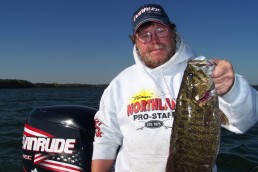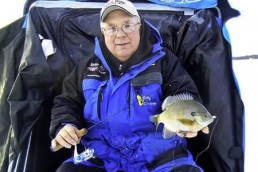How to Fish the Right Place at the Right Time
SHARE THIS POST
The “early bird catches the worm” is true, but it is only part of the story. In order to catch the worm, the bird needs to know where to find it. The same logic applies to the highly anticipated opening weekend of fishing each spring. You have to know where to find the fish.
One area to fish on opening weekend is a shallow bay, though it’s not traditionally considered a walleye-producing area. These are areas most people think of when they think early-season bass. A lot of these bays, which have shallow flats 2 feet deep and then drop off into 6 to 8 feet of water, also have a feeder creek running into them. These areas warm up and come to life in spring. The warm water brings new weed growth on the bottom, including baitfish. When these weeds are 1 to 5 inches off the bottom, the walleyes come in.
We prefer bays with a northern slope, but a southern slope can work. Most lakes have anywhere from one to three bays like this, and the beauty of these is that there is often a mix of walleyes and crappies, including the big female walleyes. Twenty years ago, most people would say that you couldn’t catch females until two weeks after they spawn because they’re resting. Tournament fishing has proved this isn’t true, as the females have shown they are ready to chow down. The key is to move around the bay, casting as you go. Once we find a school, we put the trolling motor in “anchor mode” and just pound on the fish. If you get into the crappies, you can sometimes get a fish every cast.
In 2 to 10 feet of water, we like to pitch a 1/16-ounce Mustad WL746 Elite Walleye Jig with a 2 1/2-inch Berkley Gulp Minnow on 6-pound-test Berkley NanoFil line. The beauty of using 1/16 ounce is that this presentation is a crappie-killer. In windy conditions, you will have to switch to a 1/8-ounce jig. We use either the Mustad WL746 Walleye Elite Jig or the Bass Pro Shops XPS Walleye Jigs with a 2 1/2- or 3-inch Berkley Gulp Minnow. While you won’t get many crappies with the 1/8-ounce jig, you will get bigger walleyes and even an occasional pike.
Both jigs have unique characteristics that make them great choices for walleye fishing. The Mustad WL746 Walleye Elite Jig has a round head with a razor-sharp UltraPoint hook. Not only is this hook still sharp after fishing rocks, but the longer-than-normal size of the hook allows it to come out of the back of a Berkley Gulp Minnow in the perfect spot.
The XPS Walleye Jig has a “semi-stand-up” design. This means that as the jig sits on the bottom, the hook is angled up, putting it in perfect position for a fish to inhale the offering, increasing your odds of a hook-up.
If there are a lot of big fish in the system, try using the new Berkley PowerBait Pro Shad, Jig Worm or the Rib Worm. Any tail that would work in the dead of summer will also work now for trophy fish. Just tear the jig through the weeds and pop it off the weed stems. The weeds are shorter now, so you won’t get tangled up.
The other place to target is a shallow area with structure near shoreline—more of the classic rock pattern.
Are you enjoying this post?
You can be among the first to get the latest info on where to go, what to use and how to use it!
The best spots top out at 2 to 5 feet, such as a hump that is shoreline-connected or one within close vicinity of the shore. Also, look for any shoreline spawning area with a 2- to 5-foot drop onto a shelf. Any flat that slowly tapers off, or a spine or point connected to the shoreline can also be hot, but rocks are key.
You probably won’t find many females in these areas, but there will be many males hanging around after the spawn. You can catch them by casting cranks or jigging the same types of tails you’d use on weed pattern.
The #5 Berkley Flicker Minnow is a good choice for casting, as it dives quickly and has more of a minnow- type profile for lakes that have a minnow forage base. You will need to try a #6 Berkley Flicker Shad when casting. It’s deadly, and is a lure that we designed for casting. It was important to make it neutrally buoyant and heavy enough to cast. While any shad-styled bait will get bites, it is best to steer away from a #7 or#9 early in the season, as they have a wider action. Baits with subtle action are best for casting in spring. By alternating between the shad- and minnow-style bait, you should be able to dial in the cranking presentation.
When it comes to the retrieve, slow and steady is ideal. But still being able to feel the vibration is the rule. Berkley FireLine and Berkley NanoFil are good for rocky areas. FireLine is a very tough, abrasion-resistant line that can be tied directly to the bait. In clear-water lakes, we’ll tie on a 10-pound, clear Berkley 100% Trilene fluorocarbon leader. Berkley NanoFil in 10-pound-test is a great no-stretch line. Not only does it allow you to feel the bait, but it also has the additional advantage of being a Uni-filament line, which has no braiding or fusing, making the line super-slick, adding significant casting distance.
A steady retrieve is the norm, but occasionally the lure should also touch the bottom, which will cause it to jerk off to the side. It is important to be able to feel every vibration of the lip, as walleyes will often take a swipe at the bait and miss. When this happens, you will feel the bait skip a beat. Stop reeling, count to three and then start reeling again. Often, by the time you count to two the walleyes will take another swipe and connect, just about ripping the rod out of your hands. Once you this, you will double the number of fish you catch. And you can’t get that kind of feel with monofilament line.
You can also pitch jigs in these areas with a high-action 2 1/2- to 3-inch Berkley PowerBait Pro Shad or Jig Worm. Both of these baits will jump all over the place. We typically start out with artificial baits on a rock bite, but in very clear lakes, a live bait presentation may be preferred.
Remember, in order to catch fish you have to find the fish first. So, this year on opening weekend, mix it up by hitting your traditional spots, and also take a chance on trying a bay you may have overlooked in the past to get your next bite.
MWO
SHARE THIS POST
Did you enjoy this post?
You can be among the first to get the latest info on where to go, what to use and how to use it!
Parsons/Kavajecz
Gary Parsons and Keith Kavajecz are professional walleye anglers specializing in tournament fishing and walleye fishing promotions. Both are “Legendary Angler” inductees into the National Fresh Water Fishing Hall of Fame, accomplished authors and co-hosts of the popular The Next Bite TV show. For more info: thenextbite.tv.




